Indwelling urinary catheters (IUCs) are semi-rigid, flexible tubes. They drain the bladder but block the urethra. IUCshave double lumens, or separate channels, running down it lengthwise. One of the lumen is open at both ends and allows for urine drainage by connection to a drainage bag.
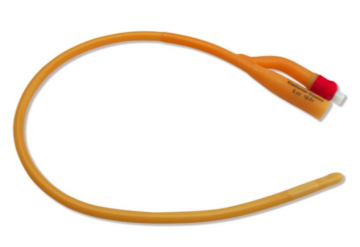
The other lumen has a valve on the outside end and connects to a balloon at the tip; the balloon is inflated with sterile water when it lies inside the bladder, and allows for retention in the bladder. These are known as two-way catheters.
The name of the Foley catheter comes from the designer, Frederic Foley, a surgeon working in Boston, Massachusetts, in the 1930s. His original design was adopted by C. R. Bard, Inc. who manufactured the first prototypes and named them in honor of the surgeon.
Foley Catheter Sizes
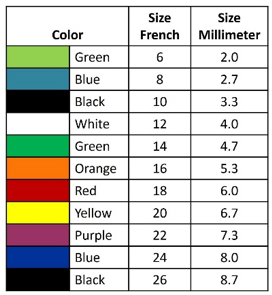
Catheter sizes are colored-coded at the balloon inflation site for easy identification
The relative size of a Foley catheter is described using French units (Fr). In general, urinary catheters range in size from 8Fr to 36Fr in diameter. 1 Fr is equivalent to 0.33 mm = .013" = 1/77" in diameter.
The crosssectional diameter of a urinary catheter is equal to three times the diameter.
Since urethral mucosa contains elastic tissue which will close around the catheter once inserted, the catheter chosen should be the smallest catheter that will adequately drain urine.
Size Considerations
- The routine use of large-size catheters diameters can cause more erosion of the bladder neck and urethral mucosa, can cause stricture formation, and do not allow adequate drainage of peri-urethral gland secretions, causing a buildup of secretions that may lead to irritation and infection.
- Larger Fr sizes (e.g., 20-24 Fr) are most commonly used for drainage of blood clots.
- The most commonly utilized indwelling transurethral and suprapubic catheters range from 14 to 16Fr in both adult females and males.
- A 14 or 16 Fr is also the standard catheter in most commercially available IUC insertion kits or trays.
- In adolescents, catheter size 14 Fr is often used but for younger children, pediatric catheter sizes of 6-12 Fr are preferred.
Shape and Design Variations
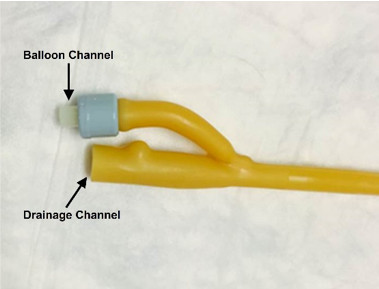
The distal end of most urinary catheters contains two ports (lumen or channel or dual lumen). One is a funnel shaped drainage channel to allow efflux of urine once the catheter is placed and the other is the inflation/deflation channel for infusion of water into the retention balloon. The infusion port for the balloon is usually labeled with the size of the balloon (5cc or 30 cc) and the size of the catheter.
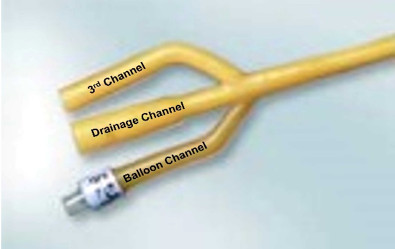
Three-way catheters are available with a third channel to facilitate continuous bladder irrigation or for instillation of medication. This catheter is primarily used following urological surgery or in case of bleeding from a bladder or prostate tumor and the bladder may need continuous or intermittent irrigation to clear blood clots or debris.
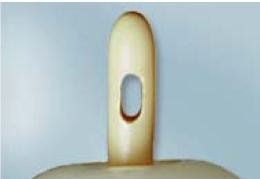
The catheter should have a smooth surface with two drainage eyes at the tip that allow for urine drainage.
Drainage eyes are placed either laterally or opposed. Opposing drainage eyes generally facilitate better drainage.
Catheter products have changed significantly in their composition, texture, and durability since the 1990s.
The challenge is to produce a catheter that matches as closely as possible to the normal physiological and mechanical characteristics of the voiding system, specifically the urethra and bladder. Foley catheters come in several subtypes, which are described in the area designs.
References
- Jahn P, Beutner K, Langer G. Types of indwelling urinary catheters for long-term bladder drainage in adults. Cochrane Database of Systematic Reviews 2012, Issue 10. Art. No.: CD004997. DOI: 10.1002/14651858.CD004997.pub3.Newman DK, Cumbee RP, Rovner ES. Indwelling (transurethral and suprapubic) catheters. In: Newman DK, Rovner ES, Wein AJ, editors. Clinical Application of Urologic Catheters and Products. Switzerland: Springer International Publishing;2018, 47-77.
- Newman DK. Devices, products, catheters, and catheter-associated urinary tract infections. In: Newman DK, Wyman JF, Welch VW, editors. Core Curriculum for Urologic Nursing. 1st ed. Pitman (NJ): Society of Urologic Nurses and Associates, Inc; 2017, 439-66.
- Newman DK. The indwelling urinary catheter: Principles for best practice. JWOCN. 2007;34:655-61 DOI: 10.1097/01.WON.0000299816.82983.4a
- Newman DK, & Wein AJ. Managing and Treating Urinary Incontinence, Second Edition. Baltimore: Health Professions Press;2009a;445-458.